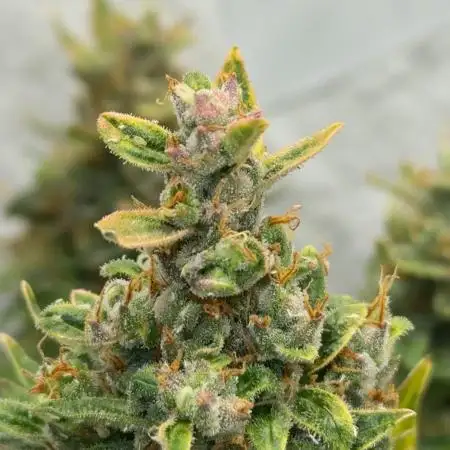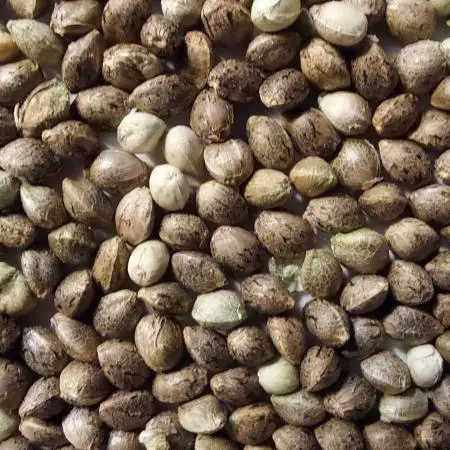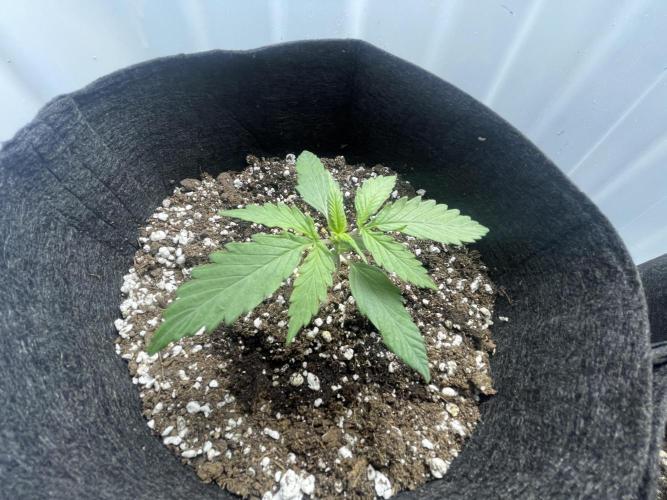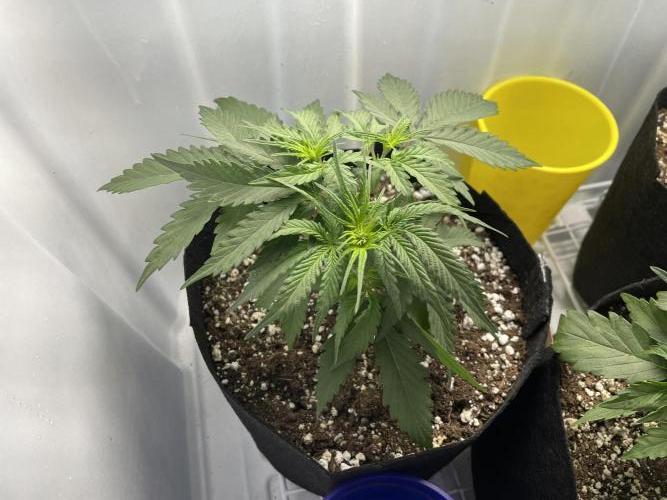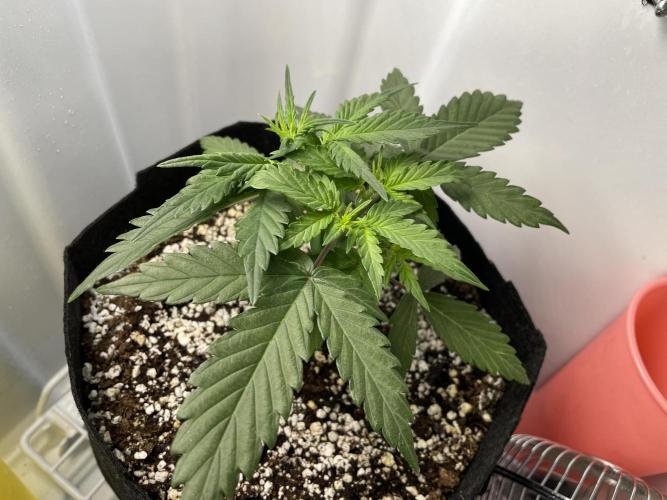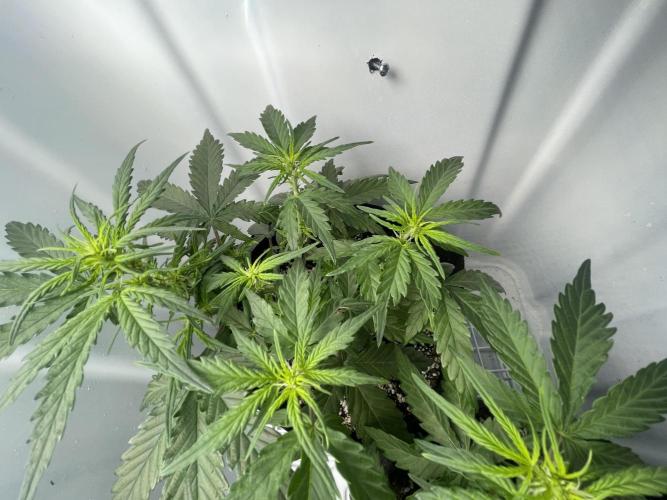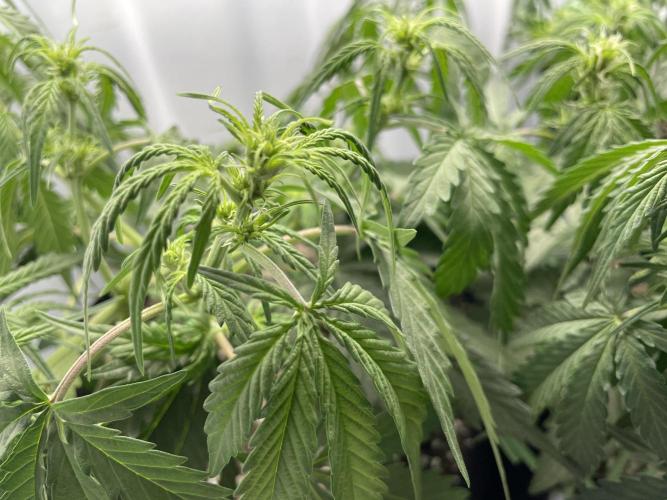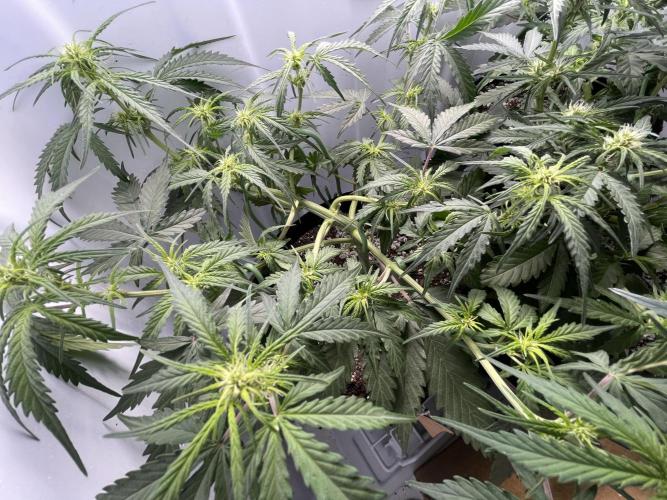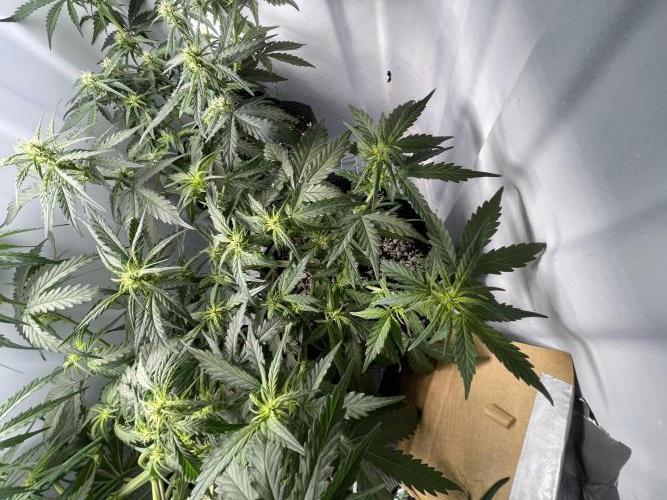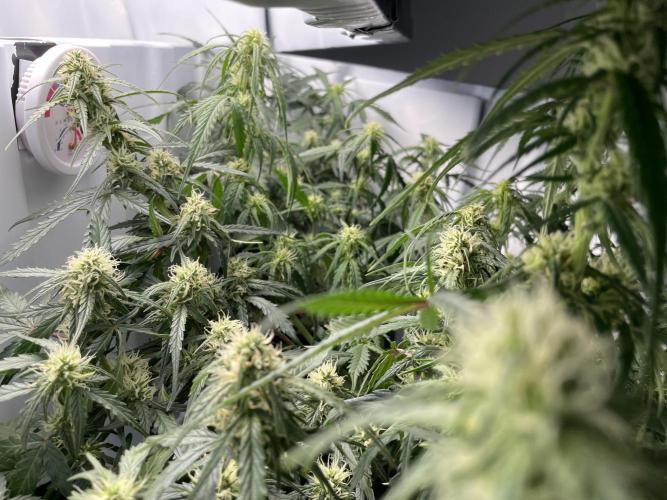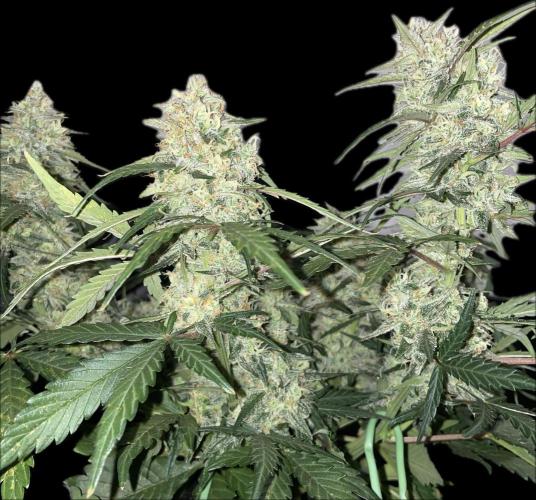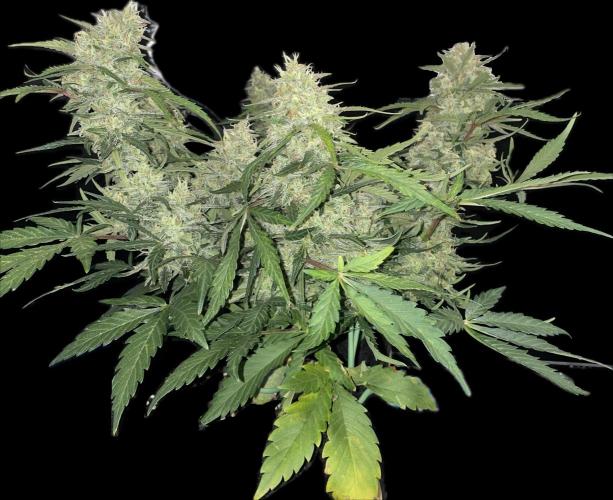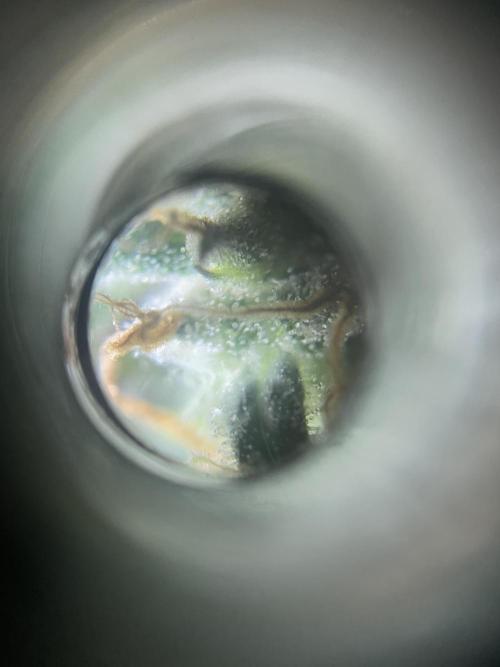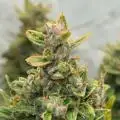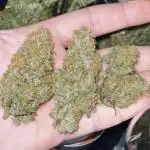The Grow Awards 2026 🏆 






























Gorilla Cookies Auto… PART 2

Tent
Grow Box 9000
DIY

Filt
Carbon Filter
DIY
Perlite
Custom
Promix BX Other
Custom
Indoor
Room Type
LST
weeks 3-8
Defoliation
weeks 5-7, 9
SoG
weeks 6-8
Leaf Tucking
weeks 7
Nutrient Taper
weeks 8
8 liters
Pot Size
2 liters
Watering
Start at Harvest
1
Week 1. Vegetation10mo ago
5.08 cm
Height
19 hrs
Light Schedule
27 °C
Day Air Temp
5.9
pH
100 PPM
TDS
65 %
Air Humidity
24 °C
Solution Temp
21 °C
Substrate Temp
24 °C
Night Air Temp
2 liters
Pot Size
0.05 liters
Watering Volume
45.72 cm
Lamp Distance
XanHalen Feb 19
Got 4 more of these girls in seedling stage, 3 are identical in development and 1 is looking like it may die, cotyledons appear to be yellowing slightly and it hasn’t grown at all since breaking surface.
For the first 2 weeks I am leaving the blurple 100watt phlizon, then switching to the 150watt viparspectra.
Beginning of week 2 I will add slight airflow within the box with a small fan.
Also thinking of using scrog net this round. Let me know thoughts and opinions!
3 likes
comments
Share
Grow Questions
XanHalenstarted grow question 10mo ago
leaves of these seedlings look weird, almost looks like light discoloration, but they also seem to be leaning toward the middle of the box for more light. Also, the perlite is turning orangey/brown, just got a new light and dont have much experience with LED or growing in general
Solved
Setup. Seedling
1 like
AsNoriuanswered grow question 10mo ago
Havent gre in bx, was using hp . Both are still soils. Preloaded soils. So your ph is too low, bump it up to 6.3-6.5 range. Have good watering cycle, wet/dry rhythm is a must. They will get better if you will adjust this .
XanHalenstarted grow question 10mo ago
I'm having trouble finding reliable info regarding what to pH my nute solution to, I read that some like to look at it as hydro (technically soilless), and others view it as soil (due to being preloaded). So 5.5 - 6 or 6 - 6.5? HELP have done full grow using 5.5-6, peep the grow.
Solved
Setup. Substrates
3 likes
00110001001001111Oanswered grow question 10mo ago
It's about the type of fertilizer you use, not the physical substrate that holds the water.
The charge that comes with BX or HP bales is ~1EC. It's very low and it'll be exhausted the first week, so it really does need fertilizer from day one despite the charge of elements.
I'd suggest shooting for 6. this gives a little leeway on each side if things go wrong. If you go a couple tenths lower or higher, nothing bad will happen and you stay near the acidic end of a good range which should improve results compared to more alkaline pH.
If you treat it as a soil and use 'soil' fertilizers, 6.5-6.8 is what you want because it helps with availability of N, which is not necessary for ingredients that provide N in hydro/soilless fertilizers. The molecules that deliver N need microbes and other forces to break it down to be plant available. This difference is behind the 'why' even if i can't explain in detail. The ingredients for soilless fertilizers are 100% dissolved and 100% plant available upon going into solution.
2
Week 2. Vegetation10mo ago
5.08 cm
Height
19 hrs
Light Schedule
24 °C
Day Air Temp
6.1
pH
480 PPM
TDS
63 %
Air Humidity
21 °C
Solution Temp
21 °C
Substrate Temp
21 °C
Night Air Temp
2 liters
Pot Size
0.15 liters
Watering Volume
43.18 cm
Lamp Distance
Nutrients 3

TriPart Micro
0.33 mll

TriPart Grow
0.33 mll

TriPart Bloom
0.33 mll
XanHalen Feb 23:
Introduced lite feed, learned about pH when using this media and I’ve been going to acidic, 6.2 is the new target.
Started with 4 all popped, one didn’t make it past a short cotyledon and died.
Wet towel wicking in a cup and a cup of dechlorinated water open managed daily keeps steady 50-65 rh no problem.
XS1500 set to 20%, 320 ppfd at the canopy.
Feb 24:
Dialed in VPD for veg, 3 open water containers and one towel wicking water from another cup, keeps rh at 70 - 75, and the small space heater set to 27C outside of the box, keeps the inside of the box at 70 - 75F.
Feb 26:
upped to 420ppfd, upped to 477ppm from 350ppm (Feb 24), (base dechlorinated tap water at 180ppm), 60 - 65% RH and 70 - 75F stable.
Feb 27:
Added a pic of a side by side of old grow at the same stage, differences between what I'm doing differently include: More light intensity and light of a more useable spectrum (FS), dialed VPD (just learned about this recently and my environment allows for easy manipulation), and I've been a bit more liberal with the nutrients (lite feed vs. 1/2 lite feed).
Feb 28:
Noticed some weird wrinkling/warping of the edges of the fan leaves near the base. Thinking its light as I had ppfd of 450-475 at canopy. I saw no reason to bring it down if there were no signs to, brought it down a hair to about 400-430. They have been tolerant of nutes and light so far on the heavier side, i wanna push these girls as far as I can without detriment.
8 likes
6 comments
Share
Grow Questions
XanHalenstarted grow question 10mo ago
Could this be light related?
Otherwise not stunted, check out diary for more info.
Everything has been dialed, but running nutes and light on the higher side.👊
Thanks for the help!💪👽
Solved
1 like
AsNoriuanswered grow question 10mo ago
Nothing too worry, would say bad air circulation ( roll down excess of pot like a sock, they dont need that wall with stagnant air inside ) and maybe heat, maybe slight underwater.
Would not stress at all.
3
Week 3. Vegetation9mo ago
5.08 cm
Height
19 hrs
Light Schedule
25 °C
Day Air Temp
6.1
pH
520 PPM
TDS
60 %
Air Humidity
21 °C
Solution Temp
21 °C
Substrate Temp
22 °C
Night Air Temp
2 liters
Pot Size
0.2 liters
Watering Volume
43.18 cm
Lamp Distance
Nutrients 3

TriPart Micro
0.33 mll

TriPart Grow
0.33 mll

TriPart Bloom
0.33 mll
XanHalen Mar 02:
So I cut down the sides of the pots to increase airflow near the base of the plant, I did this to hopefully address the curling/warping near the base of the leaf working outwards. Not certain this is the issue but starting there, if anyone has any idea what it is and what could be causing it let me know in the comments. I will upload pics of each plant to week 3 outlining this.
and added laminated sheets of paper and cut slits with a hole for the stem to come thorough to allow better light penetration to the lower canopy.
Going to begin LST on the larger 2 of the 3 in the next couple days.
Mar 05:
Tucking leaves and daily LST adjustments, snipped lower bud-sights (from the lowest node) which i didn't do last run.
450-500 ppfd, 500ppm nutes (2ml p/gal each part), 75-85F temp, 50-60% RH.
next update will outline how they took to the minor defoliation.
4 likes
1 comment
Share
Used techniques
LST
Technique
Grow Questions
XanHalenstarted grow question 9mo ago
What can be causing this, visit week 3 of the attached grow to see what i have already done to try to address this.
Solved
Leaves. Other
1 like
All_our_small_plantsanswered grow question 9mo ago
Hatte ich auch schon, bei mir war es wegen dem Licht. Waren noch zu empfindlich am Anfang und habe es etwas gedimmt nach ein paar Tagen wurde es besser. Und nach 2 Wochen habe ich es dann wieder hoch gedimmt. Hast du ein Messgerät um die Licht Stärke zu messen? Wenn nicht nutze die handy app Photone die kann dir eine. Richtwert geben von dem was du gerade hast. Ist zwar nicht 100% genau aber sie tut das was sie soll
4
Week 4. Flowering9mo ago
10.16 cm
Height
19 hrs
Light Schedule
24 °C
Day Air Temp
6.2
pH
Weak
Smell
700 PPM
TDS
55 %
Air Humidity
21 °C
Solution Temp
21 °C
Substrate Temp
22 °C
Night Air Temp
2 liters
Pot Size
0.5 liters
Watering Volume
43.18 cm
Lamp Distance
Nutrients 4

TriPart Micro
0.66 mll

TriPart Grow
0.66 mll

TriPart Bloom
0.66 mll
XanHalen Mar 8:
Looking good, lst, increased feeding volume, increasing ppm and ppfd, introducing monsterbloom when stretching halts.
Mar 9:
Explosive growth in the last 24hrs. The green coated garden wire I use for lst, the plants basically outgrew the training I did the day prior and came back to almost upright plants😂.
Re-situated them, increased ppm to 800 (5ml per gal each part), increased light intensity.
These girls are strong, great strain.
Mar 10:
Spread out the chutes, tucked some leaves, snipped a couple troublesome ones.
Increased light intensity a touch, will check PPFD tomorrow.
Added calmag 3mL/gal, upped trio to 2.5mL/gal, sitting at 940ppm, no signs of burn or slowed growth.
Increased feed volume to 500mL/day, will do a 1/2 concentrated feed every other week.
Mar 11:
Ppfd is 600-700 at the canopy, today gave a lighter 740ppm feed to the 2 bigger ones, the other was still a bit heavy. Did some defoliating and LST maintenance.
Also removed another humidity source, starting to slowly bring it down to 50-55% from 60ish
Mar 14:
The training seems to have payed off; they seem to have taken their final “form” if that makes sense, as far as their structure goes. They got like 6-8 main tops on each plant, and they look like my week 7 - 8 pictures as far as size goes. The new light, increased liberality of nutrients, and the amount of experience I gained from the first run of this strain has definitely payed off.
Can’t wait for them to stop stretching and start incorporating some monsterbloom, I wanna see how fat and dense I can get these bad girls 😈 lol.
4 likes
comments
Share
Used techniques
LST
Technique
5
Week 5. Flowering9mo ago
15.24 cm
Height
19 hrs
Light Schedule
24 °C
Day Air Temp
6.2
pH
Normal
Smell
750 PPM
TDS
55 %
Air Humidity
21 °C
Solution Temp
21 °C
Substrate Temp
22 °C
Night Air Temp
7.57 liters
Pot Size
1.89 liters
Watering Volume
30.48 cm
Lamp Distance
Nutrients 4

TriPart Micro
1.321 mll

TriPart Grow
1.321 mll

TriPart Bloom
1.321 mll
XanHalen Mar 15:
Looking good, keeping rh down has proven difficult with 3 in a 2x3x4ft box, blasting intake and exhaust with 2 fans inside.
Otherwise good, did a 1/4 feed to use up stores and salts.
Mar 16:
Looking good, dialed back in RH, Temp lowered a couple degrees, no oscillating fan so I adjust the position every day.
Want to start using MonsterBloom for some fat buds but don't wanna start too early.
Also need info if incorporating run-off feeds is necessary if i do occasional 1/4 dose feeds.
Slowly dialing back grow nutrients, and upping bloom.
New light has made 100X difference.
Mar 18th:
Will be increasing of volume per feed over the next week to 1 - 1.2L per plant, or until I get 10% run-off.
keeping concentration of feed around 800ppm,
No signs of deficiencies or toxicities yet, though colour of leaves may be a tad dark, no signs of slowed growth.
Increased PPFD to 750 - 940 at the top of the canopy.
Mar 21:
Going to start counting days not weeks, its been 36 days since they popped, so just over 5 weeks now, I was a bit ahead.
Explosive growth, still playing the "increase volume of feed until I get 10-15% runoff" game, at 1L now, will up to 1.25L for todays feed.
decreasing FloraGro by .5ml/gal every feed till I get to 1 - 1.5mL/gal.
increasing FloraBloom by .5mL/gal every feed till I get to 7 - 7.5mL/gal, or until I see P or K toxicity, whatever comes first.
That being said if I get runoff today and its 300 ppm over input, i will flush with a mild feed until I get proper output/input ppm ratio.
PLEASE, IF YOU ARE READING THIS, IF YOU SEE ME DOING SOMETHING WRONG, OR IF THERE IS A BETTER WAY, COMMENT OR DM ME 😭😂💪
3 likes
1 comment
Share
Used techniques
LST
Technique
Defoliation
Technique
Grow Questions
XanHalenstarted grow question 9mo ago
Is this clawing, or just droop, (pots fairly dry)And why can’t I get RH below 70% with more than adequate ventilation, I’m recalibrating my hygrometer in the meantime.
Solved
Leaves. Curl down
Setup. Ventilation
likes
All_our_small_plantsanswered grow question 9mo ago
Hi also auf den ersten Blick sieht es nicht so aus als ob es welche wären sie hängen wahrscheinlich nur runter. Aber mann erkennt es wahrscheinlich besser falls sie stärker werden und dann habe ich hier ein paar Tips wie du die Ursache findest
Jüngere Blätter zeigen häufig schneller Stresssymptome, wenn es zum Beispiel ein Problem mit der Nährstoffaufnahme gibt.
Ältere Blätter können ebenfalls betroffen sein, insbesondere wenn die Ursache ein länger anhaltendes Problem ist, wie Überdüngung oder schlechte Bewässerung.
Ich würde noch einpaar Tage abwarten bis du was unternimmst.
XanHalenstarted grow question 9mo ago
When should i begin supplementing with MonsterBloom, I'm in the second week of flower, and I'm using GH Trio and CalMag. peep the pics to show flowering status as of now, and peep the attached diary for more info. also, should I be watering till runoff at least once in a while?
Solved
Buds. Other
Setup. Strain - Autoflowering
Feeding. Other
1 like
00110001001001111Oanswered grow question 9mo ago
is it soilless? Yes, it is important.
And stop doing wahtever it is you think a "1/4" dose feed is.. sounds like incomplete irrigation to me. This will train roots to grow superficially as they turn toward greater moisture at the top due to the ncomplete irrigation. Watering is simple. Don't overthink it.
1) fully saturate with10% runoff (in soilless). If in soil, a minimal runoff barring any leaf symptoms is fine. This is so you don't leach off all those amendments you paid for in the soil, but you still want the entire thing to get wet. This is not "overwatering"
2) wait for appropriate loss of wait or 'dryback' -- not really about drying and more about the plant drinking.
Rinse and repeat...
If you get any droop, that is indicative of a poorly constituted substrate and nothing else... shouldn't see droop unless running a shit ton of water through th esubstrate and drowning the roots for 5-10 minutes or more. (not referring to a slow drip that takes 10-15mins to complete the task -- limits compaction doing this. this is not a large volume of water, just slow)
If making it more complicated that that, it's probably more about OCD-type behaviour than any benefit from it.
in soil if you run into a buildup in the substrate, extra runoff can help dilute that, but it's a reaction to a problem observed and not just done randomly. Flushing is stressful and slows the plant down, so tehre should be a good reason to do it. You paid for that soil, so you should minimize washing the nutrients down the drain that came with it.
Promix Bx is essentially soiless after 5-7 days. It does come with a basic pre-charge of nutes around 1EC. A plant will exhaust that very fast. I use BX or HP - whichever is cheaper at the moment, but also add enougghvermiculite to bring the sphagnum peat moss to perlite+vermiculite to 50/50 (or 1:1, whichver you prefer). This is results in a better gas:water mix.
Youou should rarely have to flush with a soilless growing method. That means you aren't adjustingn your formula based on what the plants tell you and overfeeding them for long periods of time. The 10% runoff maintains a consistent resulting EC of nutesin your substrate. This consistency is the primary benefit of soilless along with the nutes being 100% available to the plant the moment they are added. Any symptom seen is 100% caused by your formula and nothing else. (assumes it is ph-balaced. that should be common sense). This eliminates a multitude of other potential cuases to any symptom seen - making diagnosis an dfixing the problem easier -- plus, you should be able to avoid that particular problem in the future with a more optimized formula going forward.
keep nutes of not only concentration given but also ratio of each nute.. or elemental ppm of each.. fertiization is a culmination of everything you've done since it was planted, and not just last night or last week.
6
Week 6. Flowering9mo ago
22.86 cm
Height
19 hrs
Light Schedule
24 °C
Day Air Temp
6.2
pH
Weak
Smell
650 PPM
TDS
50 %
Air Humidity
21 °C
Solution Temp
21 °C
Substrate Temp
22 °C
Night Air Temp
2 liters
Pot Size
2 liters
Watering Volume
25.4 cm
Lamp Distance
Nutrients 4

TriPart Micro
1.189 mll

TriPart Grow
0.66 mll

TriPart Bloom
1.849 mll
XanHalen Mar 24:
Watering till runoff now...
runoff ppm was 2500+...
Will be using very mild nutes to flush over 1 - 3 feeds... or until I am near my input.
Mar 26:
Continuing to use 650ppm feed with bloom focus, 2L per plant gives 15% runoff...
Runoff ppm is still very high...
I wanted to check pH of runoff but the color is so vibrant i cant use the pH drops to view color, need to get a pH probe.
Plants are thriving, no issues at all. the extra fan fixed the post-water droop.
One plant is bushy and has the most bud sites,
One is the smallest but has the most uniform structure, this one has the biggest buds and thickest stalk,
One is about in the middle of the 2.
Mar 29:
one of these girls gets droopy early when its time for water, thought the canopy was too high so i tied down some more, no cigar...
gonna try increasing calmag, if that doesent work im going to reposition in the grow box to a side instead of middle, may not need the upper end ppfd...
3 likes
2 comments
Share
Used techniques
LST
Technique
Defoliation
Technique
SoG
Technique
Grow Questions
XanHalenstarted grow question 9mo ago
Watering till runoff now...
runoff ppm was 2500+...
Will be using very mild nutes to flush over 1 - 3 feeds... or until I am near my input, does this sound like an ok idea?
Solved
Other. General questions
Setup. Strain - Autoflowering
Feeding. Other
3 likes
00110001001001111Oanswered grow question 9mo ago
promix with some added perlite -- essentially soilless after first 5-7 days. Nearly identical to what i use, too.
Runoff will be different from what the substrate is. If you weren't religiously gettign 10% runoff before, you definitely had some buildup. If the plants aren't showing any major issues, just get some extra runoff well beyond 10% the next couple fertigations and it'll bring it down to a proper equilibrium.
Your plants are a bit lush, so maybe a water-only with 10% runoff for a couple irrigations is in order.
i'd do it slowly vs a 'flush' just so you don't go too far the other way. If the plant was in more dire condition, a flush would be warranted.
If you see the plant start to progress a bit lighter, go to a normal fertigation with 10% or more runoff shortly after that.
The advantage of soiless growing and 10% runoff is not that the resulting nutrient charge is exactly what you fee, but rather that it simply remains consistent. you'll chase your own tail trying to get runoff to be exactly what you feed. that is not necessary. Consistency is what allows for formula adjustments to take effect in a predictable way. Get some symptoms? adjust formula and it'll almost immediately change the reslting ratio and concentration of nutes in the substrate... maybe 80-90% transition the first 10% runoff and ~100% by 2nd.
Initial runoff will read higher than what is actually in the substrate.
I never bought a TDS probe. Don't need one. Read plant, adjust formula and stick to 10% runoff or more religiously. The plant dictates how much N/P/K/Ca/Mg/S it needs. Fine tuning of the formula is 100% from observing the plant and adjusting to what it says. When your formula works for 99% of genotypes, it's a good formula. The idea that these plants are picky stems from esoteric, imbalanced fertilizer formulas... some plants may handle it, but more than a few will not. Don't blame the plant. blame the formula. probably need 70-80% of N in flower compared to vege phase but otherwise fairly consistent levels of other nutrients have great results.
XanHalenstarted grow question 9mo ago
Does this stage look right to start using monsterbloom 1-2 times fer week?🙏👌🙌
They handle very well to aggressive feeds, runoff was 4000ppm, not a single sign of overfeeding,
That issue has been resolved, want to beef up the cake.
Solved
Buds. Other
Other. General questions
1 like
Organomananswered grow question 9mo ago
I would never use or recommend anyone give their plants a product with those numbers ........0-50-30.........it IS insane.
0-13-14 is about maximum and then only about every 10 days.
Artificially pumped up monster bloom type buds end up massive and taste like shit, but don't give you the satisfacton, flavour or quality you should be looking for.
Forcing plants with excessive feeding may get you "product", but if you want smooth smoking and tasty buds, slowly slowly is the way to go.
XanHalenstarted grow question 9mo ago
(T 65-75F, RH 45-55%, just started to water runoff 3 feeds ago, I feed 2L q48h per plant in 2 gal fabric pots, moderate nutrients, slowly upping bloom)
This plant is located directly in the middle of the box with one sister on either side, ppfd ranges from 700-1000 at canopy.
Solved
likes
00110001001001111Oanswered grow question 9mo ago
too much light is possible... is it droopy the last 2-3 hours of light cycle? Cycling from perky to droopy is okay, but if it's droopy the entire time, it's a "tired" plant that can't take anymore light relative to your co2, temp and rh conditions. Better conditions = more DLI possible.
i assume the substrate is not dry? Common sense, but sometimes it needs to be asked. Obviously, if it's dry, it is wilting as opposed to tired.
So you can rotate these around? Try putting it not in the center for a few days... then once it recovers start rotating your plants around or raise/dim light a small increment and keep it in the middle... Rotating might allow you to keep light at same intensity, which is obviously great for the other plants not in the hottest spot directly under it.
Looks like top leaves are showing some deficiency? and if any of those symptoms are in teh wrong location (the "mobile" ones), even more evidence it's the light intensity.
so, observe and find out when the droop starts.. if it's just the last several hours, probably the light intensity... even if it handled it up to this point... it may have just taken a couple weeks before it added up to enough stress to cause droop. Sometimes it's about the last several weeks or even a month of time before a symptom is visible.
7
Week 7. Flowering8mo ago
22.86 cm
Height
19 hrs
Light Schedule
22 °C
Day Air Temp
6.2
pH
Weak
Smell
750 PPM
TDS
50 %
Air Humidity
21 °C
Solution Temp
21 °C
Substrate Temp
21 °C
Night Air Temp
2 liters
Pot Size
2 liters
Watering Volume
25.4 cm
Lamp Distance
Nutrients 4

TriPart Micro
0.793 mll

TriPart Grow
0.132 mll

DualPart Bloom
1.849 mll
XanHalen Mar 31
I think things are going very well, one plant has rusty spots, pretty sure its calcium deficiency, will be upping across the board.
Got the runoff ppm to a good spot, will be going back to 800ppm feeds by week 8, 750ppm this week.
I want more stable genetics next time, I am way to new to be dealing with basically 3 different strains, that's what it feels like, and I have very little time as it is.
Thinking of upping PPFD some more, i think the droop of the one plant was just adapting to watering till runoff, I want to see some fattening AND RIGHT NOW.
3 likes
2 comments
Share
Used techniques
Defoliation
Technique
Leaf Tucking
Technique
SoG
Technique
LST
Technique
Grow Questions
XanHalenstarted grow question 8mo ago
been upping calmag .5 each feed, still getting worse, if not calcium deficiency... what is it?
should i keep upping calmag? running 2ml/gal currently.
bud development is still good, not stunted, good structure and trichomb production, great smell.
Solved
Leaves. Color - Dark-brown
Other. General questions
Feeding. Deficiences
1 like
Ultravioletanswered grow question 8mo ago
Hmmm, brown spots, most common nutrients thay cause brown spots are, Ca, Mg and K. Which also happen to be the big 3 soil cations. Bit other nutes can cause it too, the symptom of brown spots is generally causes by oxidative stress.........a symptom of oxidative stress, where an imbalance of reactive oxygen species (ROS) damages cells, leading to tissue damage and visible spots. This damage can occur due to various factors, including environmental stress, heavy metal toxicity, or pathogen infection.......
If it was from excessive light it would be growth closest to source. Leads me think it's is nute based. Little to no tip damage, ec is good, transpiration is good if water flowing.
Potassium Deficiency: A lack of potassium can cause brown spots on the edges or tips of leaves. (Responsible for tugor pressure) would be drooping too if deficienct)
Calcium Deficiency: Calcium deficiency can lead to brown spots, especially on new growth, and can also cause leaf edges to curl or become misshapen.(old growth primarily)
Magnesium Deficiency: Magnesium deficiency can cause yellowing between the veins, which can then turn brown.(possible but I don't see interveinal chlorosis)
Nitrogen Deficiency: A lack of nitrogen can cause yellowing and brown spots, especially on older leaves.(possible bit not whay I'd expect, more yellowing needed, possibly early)
Phosphorus Deficiency: Phosphorus deficiency can cause stunted growth and brown spots on leaves.
Manganese Deficiency: Manganese deficiency can cause yellowing between the veins of young leaves, followed by dark brown spots.
Boron Deficiency: Boron deficiency can cause leaves to appear small and crumpled, with brown spots, and can also cause sharp bends in the trunk.
I'd be taking a peek at soil moisture levels too, leaning towards more environmental. Who knows, get a pH before anything that always helps. Would tell me little of whats going on in the soil how saturated you are in Ca , Mg and K these 3 are vitally important for soil composition and if they are all antagonists in that they compete with each other for cations if the ratio is way off for any 1 of the 3 it can jist replace uptake of all the others wreaking havoc with the soil possibly messing with moisture retention.
People don't think of oxygen as a nutrient but it is, it's very weak bond means it easily reacts. It's a requirement in soil, in flower with the heavy canopy and increased carbon sequestration the soil in flower can become slightly wetter than one is used to.
When roots are saturated, the soil becomes waterlogged, and oxygen cannot reach the roots, leading to anoxia (oxygen deficiency).
Under anoxic conditions, plants produce reactive oxygen species (ROS), such as superoxide radicals (O2•-) and hydrogen peroxide (H2O2).
This gets shot up the stems with water and burns the epidermis layer. It's not so much a deficiency as much as it is sucking up free radicals along with everything else.
Antioxidants, like vitamins C and E, can help neutralize superoxide radicals and other ROS, preventing or minimizing the damage they cause.
If worried about chlorine use 1mg of ascorbic acid in 5 gallon jug will instantly dechlorinate and de chloramine your water. Just make sure to not add too much as it very strong acidifier.
Magnesium is a nutrient that is found as central atom in chloryphyll, although it presents as mobile nutrient within the plant. It's also constantly used and replenished throughout a plant's life, as the Magnesium is spread all over the plant it can take alot of the radicals with it all over the plant as it seeks to replenishing, basically anywhere water goes. The more water that has passed through a part of plant more damage its getting. Not so kuch mobility but a side effect of water transportation, nutrient distribution and cooling.
Soil contains reactive nitrogen species (RNS) due to both natural processes like nitrogen fixation by bacteria and human activities such as fertilizer use and fossil fuel combustion, which increase the amount of nitrogen compounds in the environment.
Reactive nitrogen species (RNS) are chemically reactive molecules containing nitrogen, like nitric oxide (NO) and its byproducts, that play diverse roles in biological systems, including signaling and defense against pathogens, but can also contribute to tissue damage. 🤔
Nitrogen toxicity is possible too and it fits but if that were case you probably would have noticed delay in flowering.
Reactive nitrogen species (RNS), particularly nitric oxide (NO), can react with reactive oxygen species (ROS), like superoxide (O2-), to form reactive nitrogen-oxygen species (RNS/ROS), such as peroxynitrite, which can lead to oxidative stress and cellular damage.
Gluck, hope she recovers strong, buds looking frosty.
8
Week 8. Flowering8mo ago
22.86 cm
Height
19 hrs
Light Schedule
22 °C
Day Air Temp
6.2
pH
Weak
Smell
750 PPM
TDS
50 %
Air Humidity
21 °C
Solution Temp
21 °C
Substrate Temp
21 °C
Night Air Temp
2 liters
Pot Size
2 liters
Watering Volume
25.4 cm
Lamp Distance
Nutrients 2

Calcium Magnesium Supplement
1.189 mll

TriPart Bloom
1.189 mll
XanHalen Apr 09:
Things are chuggin along, i think light may have been a factor in the brown spots, seeing similar symptoms on one of the other plants but very very minor in comparison....
I think it was too little calmag, i may have locked them out mid veg by using high concentration of nutes without watering till runoff (i now know, that is a no-go), and light stress. i have had them under 850-1050 ppfd when flipped to flower...
one of them is loving the light, one is big and bushy (had to defoliate later than i wanted), and one has good bud structure but pistils seem thin, and growth seems slower (the one with the brown polkadot party on its body) so thinking it may be stunted.
either way, im seeing denser buds, and im learning the ropes, thats enough for me :)
Apr 12:
Last feed day...
Trichomes look just about ready, will do 2 runoff waterings 48hrs apart, then 24-36 hr darkness...
Will try to post trichome pics....
Super excited to see the improvements from this run vs last run...!
2 likes
1 comment
Share
Used techniques
SoG
Technique
LST
Technique
Nutrient Taper
Technique
9
Week 9. Flowering8mo ago
22.86 cm
Height
19 hrs
Light Schedule
22 °C
Day Air Temp
6.2
pH
Weak
Smell
750 PPM
TDS
50 %
Air Humidity
21 °C
Solution Temp
21 °C
Substrate Temp
21 °C
Night Air Temp
2 liters
Pot Size
2 liters
Watering Volume
25.4 cm
Lamp Distance
Nutrients 3
Blood
263.908 mll
Sweat
263.908 mll
Tears
263.908 mll
XanHalen Apr 17:
48 hours darkness before harvest, we made it...
The calmag deficient one did very well all things considered...
Apr 19:
looking all cloudy with a hint of amber, im pulling the plug...
overipened last time, this should be waay better.
Smells like grime and gas idk how else to say it...
2 likes
comments
Share
Used techniques
Defoliation
Technique
10
Week 10. Harvest8mo ago
Happy Harvest Day!

8/10
Rated
One plant super sativa, one super indica, one perfect hybrid.
Indica dominant had major calcium issues, mostly my fault from overfeeding and buildup issues, but only 1 of 3 showed major deficit from this issue, perfect hybrid had calcium deficiency, but nowhere near as severe…
Apr 25th
the cure has begun, 6 day dry complete...
wet weight was the whole plant, dry weight is trimmed and jarred buds...
Apr 30th
5 days into cure, no issues with over/under 58-62% RH with integra boost packs, still haven't tried the bud, waiting a full 2 weeks!
did not go crazy on the trim, wanted to be able to choose what i want to use for edibles/rosin/bubble-hash etc.
Show more
Translate
Spent 64 days
Ger Veg Flo Har
223.33 g
Bud wet weight per plant
41.67 g
Bud dry weight per plant
3
Plants
68.58 m²
Grow Room size
Normal
Difficulty

Creative, Relaxed, Uplifted
Positive effects

Paranoia, Dry mouth
Negative effects

Stress, Depression, Insomnia
Medical effects

Diesel, Sweet, Pungent
Taste
Height
Day air temperature
Air humidity
PPM
PH
Light schedule
Solution temperature
Night air temperature
Substrate temperature
Pot size
Lamp distance
XanHalen Apr 20:
They hanging out at 65% rh and 65F..
Going for 7-10 day dry…
No wet trim, cut plants in half and hung…
Very happy with density and resin production…
Can’t wait to jar and test in 2-3 weeks…
I feel comfortable with this strain, I think it’s time to move on…
Really wanna run some Mephisto seeds….
4 likes
1 comment
Share
Equipment Reviews

the end.
Enjoying this diary? Follow for more updates!
Prefer the old Diary view?
Go back to the old Diary view












